In the world of fashion, brands play a pivotal role in shaping trends, setting style standards, and defining the industry’s landscape. While fashion brands come in various forms, from iconic mononyms to succinct acronyms, there are some that stand out for having the longest names. Today I am going to explore about 20 top fashion brands longest name and their stories behind success.
These top fashion brands, with their elaborate and extensive titles, make a statement in both their visual identity and the depth of their brand messaging. With names that go beyond conventional limits, these fashion powerhouses exude a sense of grandeur and sophistication, leaving a lasting impression on the fashion-conscious consumer.
From the moment their names roll off the tongue, they command attention and evoke a sense of exclusivity and luxury. Each long-named fashion brand carries a unique story, representing a fusion of history, vision, and creative expression. Their names often embody the ethos and values that define their brand identity, reflecting their commitment to craftsmanship, innovation, and individuality.
While it is true that a brand’s name is not solely indicative of its success or influence, these top fashion brands with the longest names have managed to carve out a prominent place in the industry. They have captivated the fashion world and captured the imagination of consumers, becoming synonymous with style, elegance, and unparalleled design.
In this exploration of top fashion brands with the longest names, we delve into the stories behind these iconic labels, uncovering the inspirations, journeys, and legacies that have shaped their esteemed status. From the design studios to the runways, these brands have left an indelible mark on the fashion landscape, perpetuating their enduring allure and captivating the hearts of fashion enthusiasts worldwide.
20 Top Fashion Brands Longest Name And Their Stories Behind Success
I am going to tell you the stories that you may not hear before. I hope this information will be interesting for you. The longest names of some fashion brands are as follows:
1. Alexander McQueen (Alexander McQueen Trading Limited) –

Alexander McQueen, born Lee Alexander McQueen, was a British fashion designer known for his groundbreaking and provocative designs. Here is a brief history of the Alexander McQueen fashion brand:
Early Life and Education:
Alexander McQueen was born on March 17, 1969, in London, England. He displayed an early interest in fashion, often creating clothes for his three sisters. McQueen pursued his passion further and went on to study fashion at Central Saint Martins College of Art and Design in London.
Early Career:
After completing his studies in 1992, McQueen started his own label under his name, Alexander McQueen. His early collections gained attention for their unconventional designs and theatrical runway presentations. His avant-garde creations challenged the traditional norms of fashion and garnered critical acclaim.
Creative Director at Givenchy:
In 1996, McQueen was appointed as the Creative Director of the French fashion house Givenchy. This opportunity allowed him to showcase his talent on a global scale. He introduced a darker, edgier aesthetic to Givenchy, blending his signature style with the brand’s elegant heritage.
Establishment of the Alexander McQueen Brand:
While working at Givenchy, McQueen continued to develop his own eponymous brand. In 2000, he entered into a partnership with the Gucci Group, which provided financial support and resources to expand the Alexander McQueen label. With this backing, McQueen gained creative freedom and launched his brand into new heights of success.
Iconic Collections and Signature Style:
Throughout his career, McQueen was known for his distinctive style and theatrical fashion shows. His collections often explored dark and macabre themes, with a mix of tailored precision and romantic fantasy. Some of his most notable collections include “Highland Rape” (1995), “The Birds” (2001), and “The Widows of Culloden” (2006).
Awards and Recognition:
Alexander McQueen received numerous awards and accolades for his contributions to the fashion industry. He was named British Designer of the Year four times and was awarded the prestigious CFDA International Designer of the Year in 2003. His designs were celebrated for their innovation, craftsmanship, and pushing boundaries.
Legacy and Posthumous Impact:
Tragically, Alexander McQueen passed away on February 11, 2010, at the age of 40. His death left a significant void in the fashion world. However, his legacy lives on, inspiring a new generation of designers and continuing to influence the industry. The brand is now led by Sarah Burton, who worked closely with McQueen and continues his vision while infusing her own creative flair.
The Alexander McQueen fashion brand remains a symbol of artistic brilliance, craftsmanship, and pushing the boundaries of fashion. McQueen’s unique perspective and innovative designs have left an indelible mark on the fashion industry.
2. Dolce & Gabbana (Dolce & Gabbana S.r.l.) –
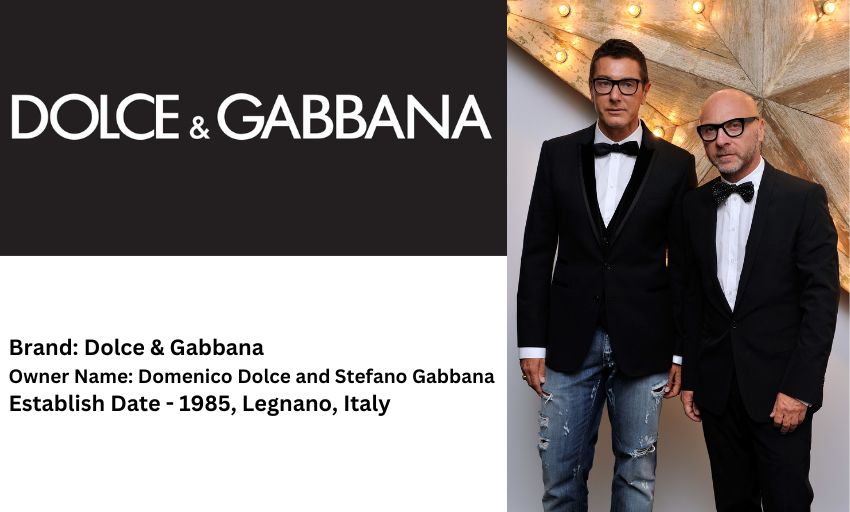
The Dolce & Gabbana fashion brand, founded by Domenico Dolce and Stefano Gabbana, has become one of the most iconic and influential luxury brands in the fashion industry. Here is a brief history of the Dolce & Gabbana fashion brand:
Founding and Early Years:
Domenico Dolce and Stefano Gabbana, both from Italy, met in Milan in the early 1980s while working as assistants in a fashion studio. In 1985, they decided to launch their own brand and presented their first women’s collection at the Milan Fashion Week. The collection received positive reviews and marked the beginning of the Dolce & Gabbana fashion brand.
Rise to Prominence:
In the late 1980s and early 1990s, Dolce & Gabbana gained significant attention and popularity. Their designs, characterized by a mix of sensuality, Sicilian influences, and bold Italian glamour, resonated with the fashion world and attracted a loyal following. Their distinctive style, often featuring corsets, lace, and animal prints, became synonymous with the brand.
Expansion and Diversification:
As the brand grew, Dolce & Gabbana expanded its offerings beyond clothing. They introduced accessories, including handbags, shoes, and eyewear, which quickly became coveted fashion items. The brand also ventured into fragrances, releasing its first scent, Dolce & Gabbana Pour Femme, in 1992. Fragrances remain a significant part of the brand’s portfolio.
Red Carpet Presence and Celebrity Endorsements:
Dolce & Gabbana established a strong presence on the red carpet, with numerous celebrities and influential figures choosing to wear their designs to high-profile events. Their glamorous and figure-flattering creations gained popularity among celebrities, including Madonna, Monica Bellucci, and Scarlett Johansson, further elevating the brand’s reputation and visibility.
Dolce & Gabbana Alta Moda and Alta Sartoria:
In 2012, the brand launched its Alta Moda (high fashion) and Alta Sartoria (high tailoring) collections. These exclusive lines offer made-to-measure, opulent creations that celebrate the artistry and craftsmanship of Italian couture. The Alta Moda and Alta Sartoria collections showcase the brand’s commitment to preserving traditional Italian craftsmanship.
Controversies and Cultural Influences:
Over the years, Dolce & Gabbana has faced some controversies. In 2015, the brand faced backlash for its controversial remarks about same-sex families, leading to a boycott by some consumers and celebrities. However, the brand continues to draw inspiration from Italian culture, traditions, and history, often incorporating them into its designs, campaigns, and runway shows.
Legacy and Global Reach:
Dolce & Gabbana has built a global brand that is recognized and revered for its bold, glamorous, and sensual designs. The brand operates numerous flagship stores worldwide, including in major fashion capitals such as Milan, New York, London, and Tokyo. Its influence extends beyond fashion, with collaborations in various industries, including music, art, and lifestyle.
The Dolce & Gabbana fashion brand remains a symbol of Italian luxury and a testament to the creative partnership between Domenico Dolce and Stefano Gabbana. Their designs continue to captivate fashion enthusiasts, and their brand has solidified its position as an iconic force in the fashion industry.
3. Giorgio Armani (Giorgio Armani S.p.A.) –
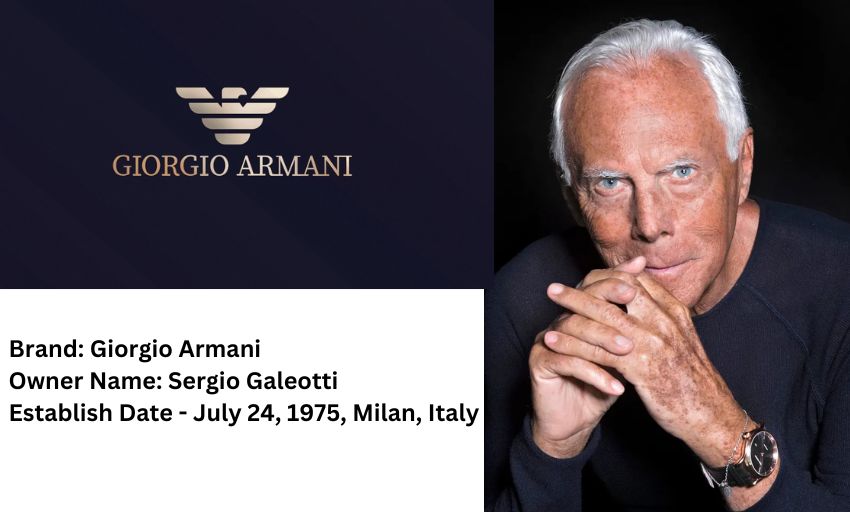
The Giorgio Armani fashion brand, founded by Giorgio Armani, is renowned for its timeless elegance, refined aesthetics, and luxurious designs. Here is a brief history of the Giorgio Armani fashion brand:
Early Life and Career:
Giorgio Armani was born on July 11, 1934, in Piacenza, Italy. He initially pursued a career in medicine but later decided to focus on his passion for fashion. Armani worked as a window dresser and buyer for a department store in Milan before becoming a freelance designer for various fashion houses in the 1960s.
Formation of Giorgio Armani Company:
In 1975, Giorgio Armani, along with his partner Sergio Galeotti, founded the Giorgio Armani Company. The brand’s first collection was launched in 1976, featuring elegant and tailored menswear. Armani’s minimalist and sophisticated designs quickly gained recognition and appealed to a discerning clientele.
Introduction of Women’s Wear:
In 1979, Armani introduced his first women’s collection, which showcased his signature clean lines, neutral colors, and luxurious fabrics. The collection captured the essence of relaxed, effortless elegance and resonated with modern, independent women. Armani’s designs became synonymous with power dressing and redefined women’s fashion.
Red Carpet Success and Celebrity Endorsements:
Throughout its history, the Giorgio Armani brand has enjoyed significant success on the red carpet. Armani’s sleek and impeccably tailored designs have been favored by numerous celebrities and influential figures. From Hollywood stars to world leaders, Armani’s creations have graced major award ceremonies and prestigious events worldwide.
Diversification and Expansion:
Over the years, the Giorgio Armani brand expanded beyond clothing to include accessories, eyewear, fragrances, cosmetics, and home furnishings. Armani’s vision of a complete lifestyle brand led to the establishment of sub-labels such as Armani Collezioni, Emporio Armani, Armani Exchange, and Armani Casa, catering to different market segments.
Armani Privé and Haute Couture:
In 2005, Armani introduced Armani Privé, the brand’s haute couture line. Armani Privé collections offer exquisite craftsmanship, intricate detailing, and luxurious fabrics. The brand has become synonymous with red carpet glamour, with celebrities frequently choosing Armani Privé for high-profile events like the Oscars and the Cannes Film Festival.
Commitment to Sustainability:
Giorgio Armani has demonstrated a commitment to sustainability and ethical practices within the fashion industry. The brand has implemented various initiatives to reduce its environmental impact, including eco-friendly production processes and the use of sustainable materials. Armani also established the “Acqua for Life” campaign, providing clean drinking water to communities in need.
Global Presence and Legacy:
The Giorgio Armani brand has achieved global recognition and success, with boutiques and flagship stores located in major cities worldwide. Armani’s influence extends beyond fashion, as he has designed costumes for films, opera, and even the Olympic Italian team. His enduring legacy as a fashion icon and innovator continues to shape the industry.
The Giorgio Armani fashion brand remains synonymous with timeless elegance, refined tailoring, and sophisticated designs. Giorgio Armani’s unwavering commitment to quality, craftsmanship, and minimalistic aesthetics has made his brand an enduring symbol of luxury and style.
4. Ralph Lauren Corporation (Ralph Lauren Corporation) –

The Ralph Lauren Corporation, founded by Ralph Lauren, is a globally recognized luxury fashion brand known for its classic and sophisticated designs. Here is a brief history of the Ralph Lauren Corporation fashion brand:
Early Life and Career:
Ralph Lifshitz, who later changed his surname to Lauren, was born on October 14, 1939, in the Bronx, New York. From a young age, Lauren had an interest in fashion and began working in the industry as a tie salesman. This experience sparked his entrepreneurial spirit and laid the foundation for his future endeavors.
Polo Ralph Lauren:
In 1967, Ralph Lauren introduced its first collection of men’s ties under the brand name “Polo Ralph Lauren.” The ties were distinctive, featuring wide, colorful designs that stood out in the market. This initial success inspired Lauren to expand his offerings beyond ties and create a complete lifestyle brand.
Polo Ralph Lauren Brand Expansion:
In the 1970s, Ralph Lauren expanded its brand by introducing a line of tailored menswear, which included iconic pieces such as the Polo shirt with the signature polo player logo. The brand’s preppy, timeless aesthetic resonated with consumers seeking a refined, American-inspired style.
Women’s Wear and Fragrances:
In 1971, Ralph Lauren launched its first women’s collection, featuring tailored clothing with a feminine touch. The women’s line offered a blend of elegance, sophistication, and a modern take on classic silhouettes. The brand further diversified its portfolio by introducing fragrances, beginning with the launch of Polo for men in 1978.
Ralph Lauren Home and Accessories:
Recognizing the importance of a complete lifestyle brand, Ralph Lauren expanded into the home decor market in 1983 with the introduction of Ralph Lauren Home. The brand offered luxurious home furnishings, bedding, and decor items. Ralph Lauren also ventured into accessories, including handbags, shoes, and eyewear.
Global Expansion and Retail Stores:
Ralph Lauren expanded its brand’s presence globally, opening retail stores in major cities worldwide. By the 1990s, the Ralph Lauren Corporation had become an internationally recognized fashion brand, synonymous with luxury and quality. The brand’s flagship stores, including the iconic Rhinelander Mansion in New York City, became destinations for fashion enthusiasts.
Collaborations and Partnerships:
The Ralph Lauren Corporation has engaged in collaborations and partnerships to further expand its brand reach. Notably, the company became an official outfitter for the U.S. Olympic team, designing and supplying the team’s uniforms for several Olympic Games. The brand also collaborated with various artists and designers, such as the celebrated interior designer, Naomi Leff.
Philanthropy and Cultural Impact:
Ralph Lauren has been actively involved in philanthropy and supporting various charitable causes. The Ralph Lauren Corporation established the Polo Ralph Lauren Foundation, which focuses on initiatives related to education, cancer research, and children’s health. Ralph Lauren’s contributions to the fashion industry have had a significant cultural impact, shaping the American fashion landscape.
The Ralph Lauren Corporation continues to be a prominent global fashion brand, renowned for its timeless designs, quality craftsmanship, and lifestyle offerings. Ralph Lauren’s vision of timeless elegance and Americana-inspired style has made his brand an enduring symbol of luxury and sophistication.
5. Roberto Cavalli (Roberto Cavalli Group) –
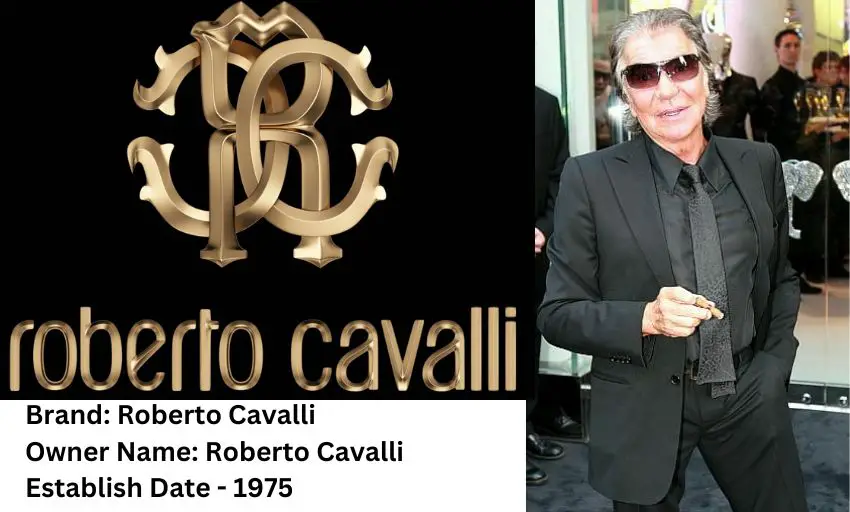
The Roberto Cavalli fashion brand, founded by Roberto Cavalli, is known for its bold, glamorous, and distinctive designs. Here is a brief history of the Roberto Cavalli fashion brand:
Early Life and Career Beginnings:
Roberto Cavalli was born on November 15, 1940, in Florence, Italy. He grew up in a family involved in the textile industry, which fostered his passion for fashion and design. Cavalli studied art and textile printing, gaining valuable knowledge and skills that would later shape his career.
Introduction of the Roberto Cavalli Brand:
In the early 1970s, Roberto Cavalli launched his eponymous brand. His designs stood out for their innovative use of prints, particularly animal prints, which became a signature element of the brand. Cavalli’s creations were characterized by bold patterns, vibrant colors, and a sense of sensuality, appealing to a fashion-forward and daring clientele.
Expansion into Clothing and Accessories:
Initially, Roberto Cavalli focused on creating printed leather items, including handbags and jackets. However, his success led him to expand into clothing, including ready-to-wear collections for men and women. Cavalli’s designs blended elements of bohemian, rock ‘n’ roll, and luxury aesthetics, creating a unique and recognizable style.
Red Carpet Success and Celebrity Endorsements:
Roberto Cavalli gained popularity and recognition through his designs’ frequent appearances on the red carpet. Celebrities and influential figures, including musicians, actors, and models, embraced Cavalli’s glamorous and attention-grabbing creations. His designs became synonymous with sexy, confident, and extravagant fashion statements.
Roberto Cavalli Home and Lifestyle:
Beyond fashion, Roberto Cavalli extended his brand into the lifestyle market. He introduced Roberto Cavalli Home, offering luxurious home furnishings, furniture, and interior design accessories. The brand expanded further to include fragrances, eyewear, watches, and other lifestyle products, diversifying its offerings.
Collaborations and Partnerships:
Roberto Cavalli engaged in collaborations and partnerships to expand the brand’s reach and explore new avenues. Notably, the brand collaborated with H&M in 2007 to create an affordable collection, making Cavalli’s designs more accessible to a wider audience. The brand also partnered with other companies for licensing agreements in various product categories.
Ownership Changes and Brand Evolution:
Over the years, the Roberto Cavalli brand went through changes in ownership. In 2019, the brand was acquired by the Italian fashion group, OTB (Only the Brave), which also owns other well-known fashion labels. Under new ownership, the brand has continued to evolve and adapt to changing fashion trends and consumer preferences.
Legacy and Impact:
The Roberto Cavalli fashion brand has left a lasting impact on the fashion industry, known for its bold prints, sensual designs, and luxurious aesthetic. Roberto Cavalli’s innovative approach to incorporating animal prints and his daring use of materials and embellishments have influenced subsequent generations of designers.
Today, the Roberto Cavalli brand continues to offer distinctive designs, embodying a sense of glamour, individuality, and confidence. Despite changes in ownership, the brand remains a recognizable and influential name in the fashion world, with a legacy that reflects Roberto Cavalli’s artistic vision and creative spirit.
6. Maison Margiela (Maison Martin Margiela Paris) –
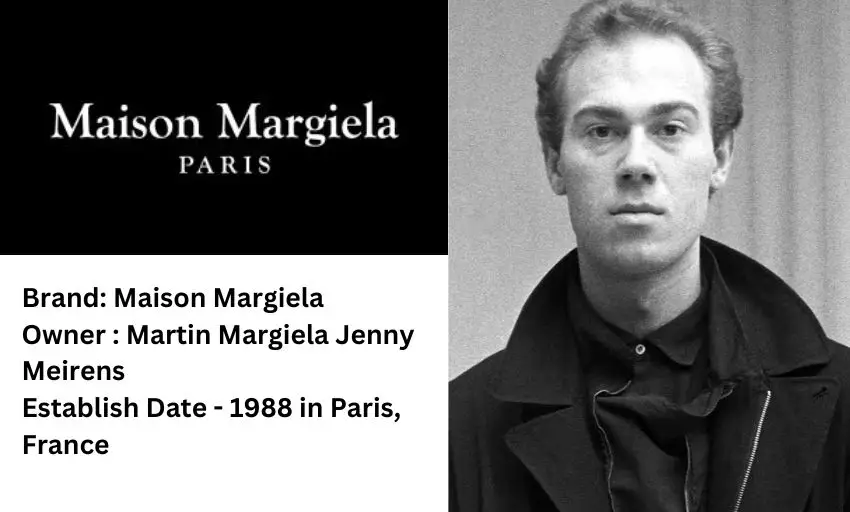
The Maison Margiela fashion brand, often referred to as simply “Margiela,” is renowned for its avant-garde and conceptual approach to fashion. Here is a brief history of the Maison Margiela fashion brand:
Founding and Early Years:
Maison Margiela was founded in 1988 by Belgian designer Martin Margiela. After graduating from the Royal Academy of Fine Arts in Antwerp, Margiela worked as an assistant to Jean Paul Gaultier before launching his own brand. Maison Margiela quickly gained attention for its unconventional designs, deconstructed silhouettes, and emphasis on anonymity and collective creativity.
The “Tabi” Boot and Iconic Design Elements:
One of the most iconic creations associated with Maison Margiela is the “Tabi” boot, featuring a split-toe design. Introduced in 1989, the Tabi boot became an instantly recognizable symbol of the brand’s innovative and distinctive aesthetic. Other design elements associated with Maison Margiela include trompe l’oeil prints, unfinished hems, and the use of repurposed materials.
Anonymity and Collective Spirit:
Maison Margiela challenged the traditional notion of the designer as a singular, public figure. Martin Margiela himself remained elusive, avoiding interviews and public appearances. The focus was on the collective spirit of the Maison Margiela team, with the belief that the ideas and creative process were more important than individual personalities.
Artistic Collaborations:
Maison Margiela collaborated with various artists and creatives, blurring the boundaries between fashion and art. Notable collaborations include projects with photographers such as Inez van Lamsweerde and Vinoodh Matadin, as well as partnerships with artists like Anish Kapoor and Cindy Sherman. These collaborations pushed the boundaries of fashion and added an artistic dimension to the brand’s identity.
Expansion and Acquisition:
Over the years, Maison Margiela expanded its offerings beyond clothing to include accessories, fragrances, and home decor. In 2002, the brand was acquired by the OTB (Only The Brave) group, led by Renzo Rosso. This partnership provided resources and support for further growth while allowing the brand to maintain its distinct creative vision.
Evolution and Succession:
In 2009, Martin Margiela stepped down from the Maison Margiela brand, handing over the creative direction to a collective of designers. Since then, the brand has continued to evolve while staying true to its avant-garde heritage. John Galliano, a British designer known for his theatrical and imaginative designs, took over as the creative director in 2014, bringing his unique perspective to the Maison Margiela aesthetic.
Legacy and Influence:
Maison Margiela’s influence on the fashion industry is significant, particularly in the realms of deconstruction, unconventional tailoring, and the blending of art and fashion. The brand’s conceptual approach and commitment to pushing boundaries have inspired countless designers and shaped the conversation around creativity in fashion.
The Maison Margiela fashion brand continues to captivate and challenge fashion enthusiasts with its thought-provoking designs and artistic collaborations. Its commitment to innovation, anonymity, and collective creativity ensures that the Maison Margiela legacy remains influential and relevant in the ever-evolving world of fashion.
7. Christian Dior (Christian Dior SE) –
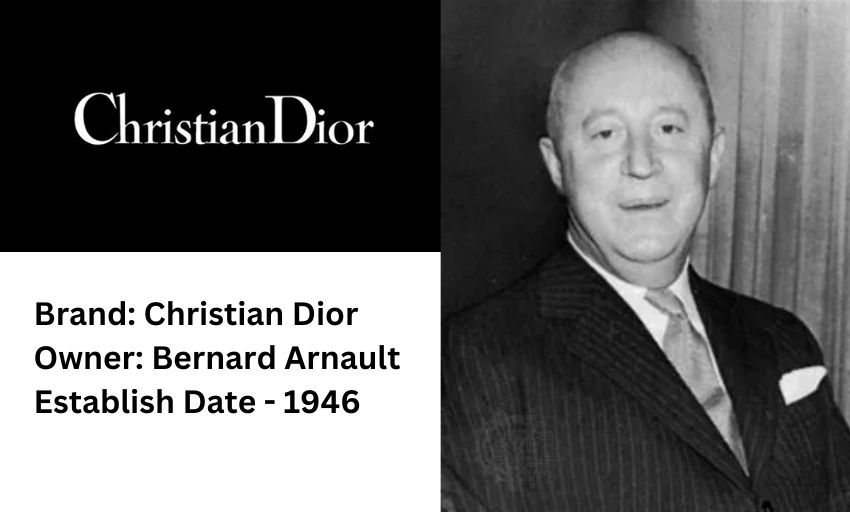
The Christian Dior fashion brand, commonly known as Dior, is a legendary name in the world of fashion, renowned for its elegant designs, luxurious fabrics, and timeless appeal. Here is a brief history of the Christian Dior fashion brand:
Founding and the “New Look”:
Christian Dior founded his eponymous brand in 1946 after working for several fashion houses. In 1947, Dior presented his first collection, which would become famously known as the “New Look.” The collection featured cinched waists, full skirts, and a return to feminine elegance, revolutionizing post-war fashion and establishing Dior as a leading couturier.
Global Recognition and Expansion:
The “New Look” catapulted the Dior brand to international fame. Dior’s designs quickly became sought after by fashionable women around the world, including celebrities and royalty. The brand expanded its offerings beyond clothing to include accessories, fragrances, and later, cosmetics. Dior boutiques were opened in major cities globally, solidifying the brand’s global presence.
The “H-Line” and Succession:
After Christian Dior’s untimely death in 1957, his young assistant Yves Saint Laurent took over as the head designer, introducing the “H-Line” collection, which featured a more streamlined silhouette. Saint Laurent’s tenure at Dior was short-lived as he left to establish his own fashion house. Subsequent creative directors, including Marc Bohan, Gianfranco Ferré, John Galliano, Raf Simons, and Maria Grazia Chiuri, each contributed their unique vision and design aesthetic to the brand.
Haute Couture and Iconic Designs:
Dior has long been associated with haute couture, creating exquisite and meticulously crafted garments. The brand’s ateliers in Paris continue to produce highly coveted made-to-measure pieces for a discerning clientele. Dior has also introduced ready-to-wear collections, including the iconic Lady Dior handbag, the J’adore fragrance line, and the iconic Dior Homme menswear.
Miss Dior and Celebrity Endorsements:
The Dior brand gained further recognition through iconic advertising campaigns and celebrity endorsements. The Miss Dior fragrance, introduced in 1947, became a global sensation and remains an iconic scent. Over the years, Dior collaborated with renowned photographers and celebrities, further cementing its status as a glamorous and aspirational brand.
Architectural Influence:
The brand’s influence extends beyond fashion, with Dior’s architectural vision leaving a mark on the industry. The House of Dior’s headquarters in Paris, designed by renowned architect Christian de Portzamparc, showcases the brand’s commitment to modernity and elegance.
Commitment to Sustainability and Philanthropy:
In recent years, Dior has focused on sustainable practices and ethical fashion. The brand has implemented initiatives to reduce its environmental impact and has championed causes such as women’s empowerment. Dior has also supported philanthropic efforts, including the educational foundation, the Fondation Christian Dior.
Legacy and Enduring Influence:
The Christian Dior fashion brand continues to be an influential force in the fashion industry. Dior’s timeless designs, attention to detail, and commitment to craftsmanship have shaped the modern aesthetic and inspired countless designers. The brand’s rich heritage and dedication to elegance have ensured its enduring legacy as a symbol of luxury and sophistication.
Today, the Christian Dior fashion brand remains a pillar of the fashion world, combining heritage and innovation to create garments and accessories that capture the essence of timeless style and feminine allure.
8. Carolina Herrera (Carolina Herrera New York) –
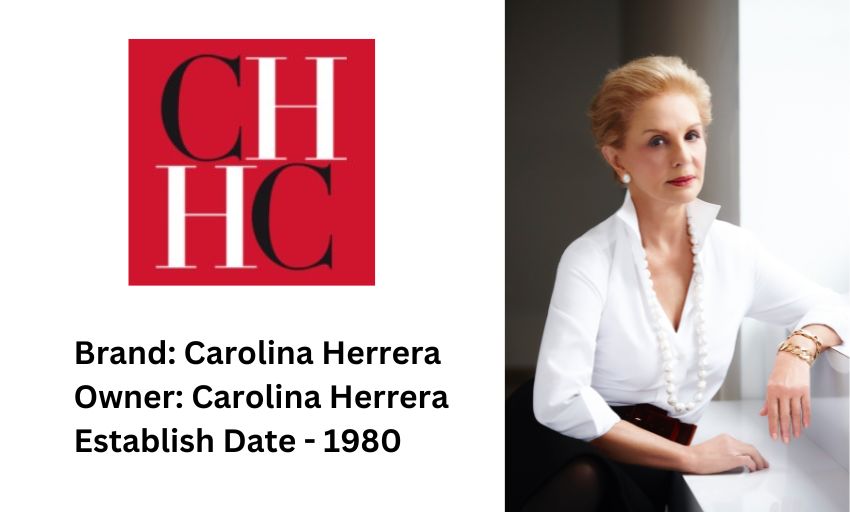
The Carolina Herrera fashion brand, founded by the Venezuelan-born designer Carolina Herrera, is renowned for its sophisticated and elegant designs. Here is a brief history of the Carolina Herrera fashion brand:
Early Life and Career Beginnings:
Carolina Herrera was born on January 8, 1939, in Caracas, Venezuela. She grew up in a wealthy and influential family, which exposed her to the world of fashion and style from a young age. Herrera’s grandmother, a renowned socialite, instilled in her a sense of refined taste and elegance.
Entry into the Fashion World:
Carolina Herrera’s foray into the fashion industry began in the early 1970s when she moved to New York City. Her impeccable personal style and social connections caught the attention of fashion editors and influential figures, propelling her into the world of high fashion.
Launch of the Carolina Herrera Brand:
In 1980, Carolina Herrera launched her eponymous fashion brand, debuting her first collection at the Metropolitan Club in New York City. The collection was an instant success, garnering praise for its timeless and feminine designs, luxurious fabrics, and attention to detail.
Signature Style and Design Philosophy:
Carolina Herrera’s designs are characterized by their classic and timeless aesthetic, often featuring clean lines, tailored silhouettes, and luxurious materials. Her approach to fashion emphasizes elegance, sophistication, and refined femininity, attracting a loyal following of stylish women around the world.
Red Carpet and Celebrity Influence:
Carolina Herrera’s designs have become a favorite among celebrities, who frequently wear her creations on red carpets and at prestigious events. Her elegant gowns have been worn by prominent figures, including First Ladies, actresses, and influential women in various industries, solidifying the brand’s reputation as a go-to for glamorous and sophisticated eveningwear.
Expansion and Diversification:
Over the years, the Carolina Herrera brand has expanded its offerings beyond clothing to include accessories, fragrances, and home decor. The brand’s fragrance line, including the iconic “Carolina Herrera” and “212” scents, has been highly successful and well-received globally.
Succession and New Creative Directors:
In 2018, Carolina Herrera announced her decision to step down as the creative director of her eponymous brand, passing the reins to Wes Gordon, who had been working alongside her since 2016. Under Gordon’s creative direction, the brand continues to embody Herrera’s signature style while infusing youthful and modern energy.
Legacy and Influence:
Carolina Herrera has left an indelible mark on the fashion industry. Her unwavering commitment to timeless elegance and refined femininity has made her brand an enduring symbol of luxury and sophistication. Her influence extends beyond the runway, shaping the way women dress and empowering them with a sense of confidence and grace.
Today, the Carolina Herrera fashion brand remains a beacon of timeless style, synonymous with refined elegance and sophistication. With a commitment to impeccable craftsmanship and a dedication to preserving its founder’s vision, the brand continues to captivate fashion enthusiasts around the world.
9. Givenchy (Givenchy Couture) –
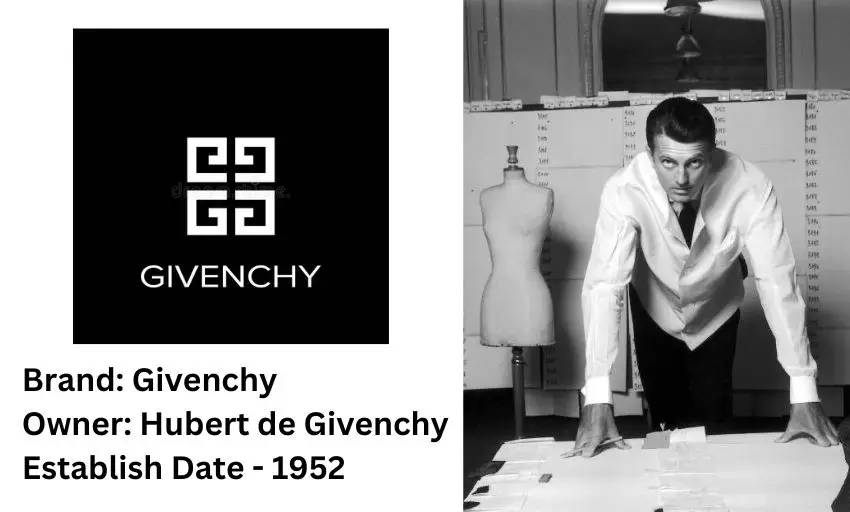
The Givenchy fashion brand, founded by the French designer Hubert de Givenchy, is renowned for its chic and sophisticated designs that have become synonymous with timeless elegance. Here is a brief history of the Givenchy fashion brand:
Early Life and Career Beginnings:
Hubert de Givenchy was born on February 21, 1927, in Beauvais, France. His passion for fashion was evident from a young age, and he moved to Paris in the late 1940s to pursue his dreams. Givenchy honed his skills working for prominent fashion houses, including Jacques Fath and Elsa Schiaparelli, before establishing his own brand.
Launch of the Givenchy Brand:
In 1952, Hubert de Givenchy launched his eponymous fashion brand, presenting his first collection that showcased his signature blend of French elegance and innovation. The brand quickly gained attention for its exquisite designs, impeccable craftsmanship, and attention to detail.
Relationship with Audrey Hepburn:
Givenchy’s association with the iconic actress Audrey Hepburn played a significant role in elevating the brand’s status and global recognition. Givenchy became Hepburn’s preferred designer and collaborated with her on numerous film wardrobes, including the iconic little black dress from the movie “Breakfast at Tiffany’s.” Their partnership solidified Givenchy’s place as a fashion house associated with grace, sophistication, and timeless style.
Expansion and Product Lines:
Over the years, the Givenchy brand expanded its offerings beyond clothing to include accessories, fragrances, cosmetics, and eyewear. The brand’s perfumes, such as “L’Interdit” and “Very Irrésistible,” became highly successful and have remained popular choices among fragrance enthusiasts.
Creative Directors and Succession:
Hubert de Givenchy led the brand for several decades before retiring in 1995. He was succeeded by a series of talented creative directors who have added their unique vision to the brand. Notable creative directors include John Galliano, Alexander McQueen, Julien Macdonald, Riccardo Tisci, and most recently, Matthew M. Williams.
Influence on Fashion:
Givenchy has been influential in shaping the fashion industry. The brand’s designs have embodied a harmonious blend of classicism and modernity, and its contributions to women’s fashion have been particularly noteworthy. Givenchy’s sleek and tailored silhouettes, refined color palettes, and use of luxurious fabrics have set trends and inspired designers worldwide.
Legacy and Enduring Appeal:
The Givenchy brand continues to be revered for its timeless and refined aesthetic. It has maintained its position as a symbol of luxury and sophistication, attracting a loyal clientele and remaining relevant in the ever-changing fashion landscape. Givenchy’s designs continue to grace red carpets, high-profile events, and the wardrobes of fashion-forward individuals around the world.
The Givenchy fashion brand’s rich history and dedication to craftsmanship, elegance, and innovation have solidified its place as one of the most iconic and influential fashion houses in the world. With a legacy built on the vision of Hubert de Givenchy and the contributions of talented designers who followed, the brand remains a cornerstone of French haute couture and a beacon of timeless style.
10. Michael Kors (Michael Kors Holdings Limited) –
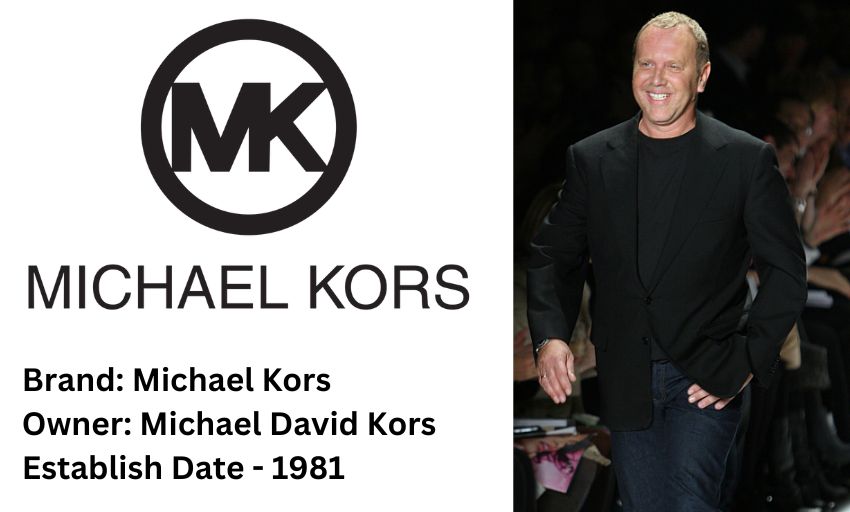
The Michael Kors fashion brand, founded by American designer Michael Kors, has become synonymous with luxury, effortless style, and a jet-set aesthetic. Here is a brief history of the Michael Kors fashion brand:
Early Life and Career Beginnings:
Michael Kors was born on August 9, 1959, in Long Island, New York. He developed a passion for fashion at a young age and began designing clothes in his teenage years. Kors attended the Fashion Institute of Technology in New York City but dropped out after two semesters to pursue a career in fashion.
Launch of the Michael Kors Brand:
In 1981, at the age of 22, Michael Kors launched his eponymous fashion brand, starting with a collection of women’s clothing. His designs were immediately well-received for their clean lines, luxurious fabrics, and timeless sophistication.
Success in American Fashion:
Michael Kors quickly gained recognition in the American fashion industry for his ability to create designs that were both fashionable and wearable. His brand captured the spirit of American sportswear, combining casual elegance with a sense of effortless glamour. Kors’ designs appealed to a wide range of women, from fashion-conscious professionals to celebrities.
Expansion and Diversification:
Over the years, the Michael Kors brand expanded its offerings to include accessories, footwear, and fragrances. The brand’s accessories, particularly handbags and watches, became highly sought after and contributed significantly to its success. The brand’s jet-set aesthetic and luxurious yet accessible designs resonated with a global audience.
Initial Public Offering and Global Expansion:
In 2004, the Michael Kors brand went public with its initial public offering (IPO) on the New York Stock Exchange. This allowed the brand to further expand its reach and establish a global presence. Michael Kors boutiques opened in major cities around the world, solidifying the brand’s status as a global fashion powerhouse.
Celebrity Endorsements and Popularity:
Michael Kors gained popularity and widespread recognition through his appearances as a judge on the television show “Project Runway.” The exposure on the show, along with endorsements from celebrities and high-profile individuals, helped to elevate the brand’s profile and attract a broader customer base.
Acquisition of Other Fashion Brands:
In recent years, the Michael Kors brand has expanded through strategic acquisitions. In 2017, the company acquired Jimmy Choo, a renowned luxury shoe brand, followed by the acquisition of Versace in 2018. These acquisitions allowed the Michael Kors company, now known as Capri Holdings, to diversify its brand portfolio and solidify its position as a global luxury fashion conglomerate.
Commitment to Philanthropy and Sustainability:
The Michael Kors brand has been actively involved in philanthropic initiatives, particularly in the areas of hunger relief and access to education. Additionally, the brand has made efforts to become more sustainable by incorporating eco-friendly practices into its supply chain and reducing its environmental impact.
Today, the Michael Kors fashion brand remains a prominent name in the fashion industry, celebrated for its luxurious yet accessible designs and its ability to capture the spirit of modern American style. Michael Kors’ vision of timeless elegance, combined with the brand’s commitment to quality and craftsmanship, has ensured its enduring popularity among fashion-conscious individuals worldwide.
11. Tom Ford (Tom Ford International LLC) –
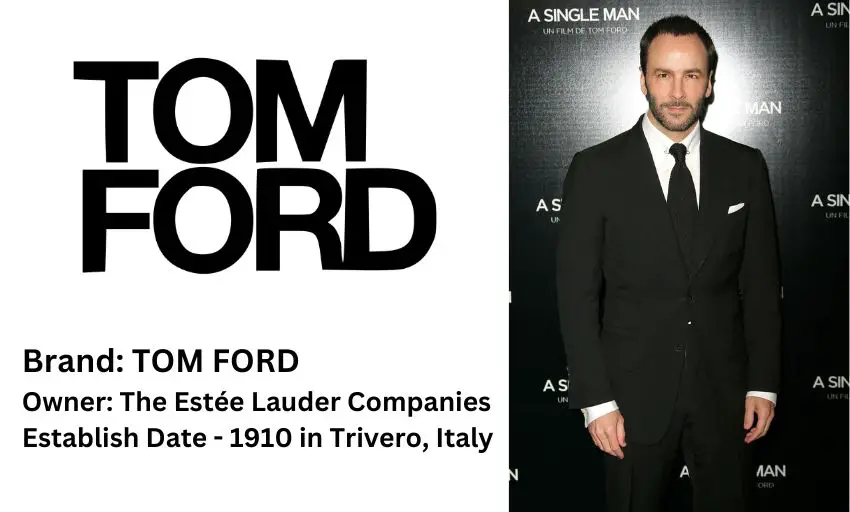
The Tom Ford fashion brand, founded by American designer Tom Ford, is renowned for its provocative and glamorous designs that blend sophistication, sensuality, and impeccable craftsmanship. Here is a brief history of the Tom Ford fashion brand:
Early Life and Career Beginnings:
Tom Ford was born on August 27, 1961, in Austin, Texas. He developed a passion for fashion at a young age and studied architecture before pursuing a career in fashion design. Ford attended Parsons School of Design in New York City and later trained under renowned designer Cathy Hardwick.
Success at Gucci:
In 1990, Tom Ford joined the Italian fashion house Gucci as the company’s womenswear designer. Ford’s innovative and daring designs revitalized the brand, taking it from the verge of bankruptcy to a global powerhouse. Under Ford’s creative direction, Gucci became known for its sensual and provocative aesthetic, incorporating bold colors, sleek silhouettes, and luxurious fabrics.
Expansion and Creative Control:
As Ford’s influence at Gucci grew, he took on additional responsibilities and eventually became the creative director of the entire Gucci Group, which included brands like Yves Saint Laurent and Bottega Veneta. Ford’s visionary approach and business acumen allowed him to successfully oversee the creative direction of multiple luxury brands within the group.
Launch of the Tom Ford Brand:
In 2005, after leaving Gucci, Tom Ford launched his eponymous brand, starting with a line of luxury menswear. The brand’s debut collection showcased Ford’s signature style, characterized by sleek tailoring, attention to detail, and a modern take on classic menswear.
Diversification and Global Recognition:
The Tom Ford brand expanded its offerings beyond menswear to include women’s clothing, accessories, eyewear, fragrances, and beauty products. Ford’s designs, which often exude sensuality and glamour, have gained a cult following among celebrities and fashion enthusiasts worldwide. The brand has become synonymous with red carpet elegance and luxury.
Film and Cultural Influence:
Tom Ford’s creative vision extends beyond fashion. In 2009, he made his directorial debut with the critically acclaimed film “A Single Man,” which received widespread praise for its style and storytelling. Ford’s background in film and his keen eye for aesthetics have influenced his fashion designs, resulting in visually striking collections that often reference cinematic influences.
Commitment to Craftsmanship and Quality:
The Tom Ford brand is known for its meticulous attention to detail and commitment to craftsmanship. Each piece is crafted with the finest materials and undergoes rigorous quality control to ensure excellence. Ford’s emphasis on quality and luxury has contributed to the brand’s reputation as a symbol of prestige and refinement.
Retail Expansion and Global Presence:
Tom Ford boutiques can be found in major cities around the world, including New York, London, Milan, Tokyo, and Los Angeles. The brand’s retail presence allows customers to experience the world of Tom Ford firsthand and showcases the brand’s commitment to creating an immersive and luxurious shopping experience.
Today, the Tom Ford fashion brand remains a prominent name in the industry, celebrated for its bold and sensual designs that capture the essence of modern luxury. Tom Ford’s distinct aesthetic, combined with his attention to detail and unwavering commitment to craftsmanship, has solidified the brand’s status as a leading force in the fashion world.
12. Stella McCartney (Stella McCartney Limited) –

The Stella McCartney fashion brand, founded by British designer Stella McCartney, is celebrated for its sustainable and cruelty-free approach to fashion, combining ethical values with modern, feminine designs. Here is a brief history of the Stella McCartney fashion brand:
Early Life and Career Beginnings:
Stella McCartney was born on September 13, 1971, in London, England. As the daughter of renowned musician Sir Paul McCartney and photographer Linda McCartney, she was exposed to the world of art and creativity from a young age. McCartney developed an interest in fashion and pursued her passion by studying at Central Saint Martins College of Art and Design in London.
Partnership with Chloé:
After graduating from college, Stella McCartney gained valuable experience working as an intern for Christian Lacroix and later joined the Paris-based fashion house Chloé as creative director in 1997. Her appointment at Chloé catapulted her into the spotlight, as she infused the brand with her modern, feminine aesthetic and garnered critical acclaim for her designs.
Launch of the Stella McCartney Brand:
In 2001, Stella McCartney launched her eponymous fashion brand in collaboration with the Gucci Group (now Kering). The brand’s debut collection showcased McCartney’s commitment to sustainability, using vegetarian-friendly materials and avoiding the use of fur and leather in her designs. Her collections embodied a modern and effortless style that resonated with women seeking elegant and wearable fashion.
Sustainable and Ethical Practices:
Stella McCartney has been a trailblazer in promoting sustainability and ethical practices in the fashion industry. The brand has consistently championed the use of organic cotton, recycled materials, and innovative eco-friendly fabrics. McCartney’s commitment to cruelty-free fashion extends to her refusal to use fur, leather, or exotic skins, making her brand a pioneer in sustainable luxury fashion.
Collaborations and Partnerships:
Throughout the years, the Stella McCartney brand has collaborated with various brands and organizations to further promote sustainable fashion. Notable collaborations include partnerships with Adidas for a line of athletic wear, and with tech giant Google for the development of sustainable materials and innovations in fashion.
Expansion and Product Offerings:
The Stella McCartney brand has expanded its product offerings to include ready-to-wear collections for women, men, and children, as well as accessories, handbags, shoes, and fragrances. McCartney’s designs continue to be recognized for their effortless elegance, feminine silhouettes, and attention to detail.
Awards and Recognition:
Stella McCartney’s commitment to sustainable fashion has garnered her numerous awards and accolades. The brand has received recognition for its ethical practices, innovative designs, and contributions to the fashion industry’s shift toward sustainability. McCartney herself has been honored with prestigious awards, including the Order of the British Empire (OBE) for services to fashion.
Global Presence and Brand Impact:
The Stella McCartney brand has established a global presence, with boutiques in major cities worldwide, including London, Paris, New York, Tokyo, and Shanghai. McCartney’s designs have attracted a diverse clientele of fashion-conscious individuals who appreciate the brand’s fusion of style and sustainability.
Today, the Stella McCartney fashion brand continues to be a leading force in the industry, championing sustainable and ethical practices while creating beautiful, modern designs. McCartney’s unwavering commitment to fashion with a conscience has solidified the brand’s position as an icon of sustainable luxury, inspiring others to follow in her footsteps and redefine the fashion industry’s relationship with the environment and animals.
13. Alexander Wang (Alexander Wang Inc.) –
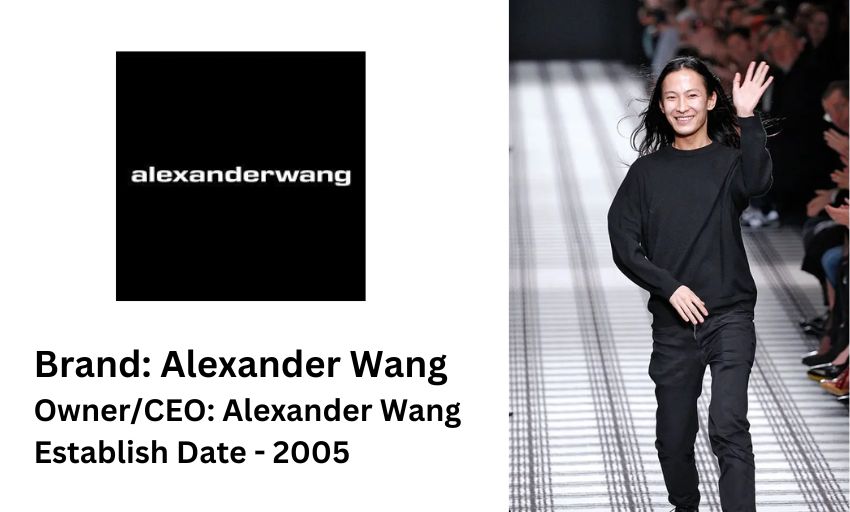
The Alexander Wang fashion brand, founded by American designer Alexander Wang, is known for its urban, edgy, and effortlessly cool aesthetic. Here is a brief history of the Alexander Wang fashion brand:
Early Life and Career Beginnings:
Alexander Wang was born on December 26, 1983, in San Francisco, California. He developed an interest in fashion at a young age and attended Parsons School of Design in New York City. During his time at Parsons, Wang gained attention for his talent and unique vision, winning the prestigious CFDA/Vogue Fashion Fund in 2008.
Launch of the Alexander Wang Brand:
In 2005, at the age of 21, Alexander Wang launched his eponymous fashion brand with a focus on womenswear. His debut collection, showcased in 2007, was an instant success, catching the attention of both industry insiders and fashion enthusiasts. Wang’s designs stood out for their urban and downtown vibe, blending elements of streetwear with high fashion.
Signature Pieces and Design Philosophy:
The Alexander Wang brand became known for its minimalist yet edgy aesthetic. Wang’s designs often feature clean lines, oversized silhouettes, and an emphasis on black and neutral tones. He introduced signature pieces, such as slouchy T-shirts, leather jackets, and cut-out dresses, that have become iconic staples in his collections.
Collaborations and Special Projects:
Alexander Wang has collaborated with various brands and designers, expanding his reach and creating unique offerings. Notable collaborations include partnerships with H&M, Adidas, and Uniqlo, resulting in highly sought-after limited edition collections. Wang’s collaborations allowed him to tap into new markets and bring his distinctive aesthetic to a wider audience.
New York Fashion Week and Runway Shows:
The Alexander Wang brand quickly gained recognition on the New York Fashion Week circuit. Wang’s runway shows became highly anticipated events, known for their energy, unconventional presentation formats, and innovative use of venues. He often pushed boundaries, incorporating elements of performance art and surprise guest appearances into his shows.
Menswear and Accessories:
In 2011, Alexander Wang expanded his brand to include menswear, offering his signature urban style to a new audience. The menswear collections feature a mix of tailored pieces, sportswear influences, and streetwear aesthetics. Additionally, the brand offers a range of accessories, including handbags, shoes, and eyewear, which have become popular among fashion enthusiasts.
Alexander Wang as Creative Director:
In addition to his eponymous brand, Alexander Wang has served as the creative director for other fashion houses. From 2012 to 2015, he was the creative director at Balenciaga, where he brought his unique perspective to the luxury brand. His tenure at Balenciaga further solidified his position as a visionary designer with a strong design identity.
Retail Expansion and Global Presence:
The Alexander Wang brand has expanded its retail presence, with boutiques in major cities worldwide, including New York, London, Tokyo, and Beijing. The brand’s global reach has attracted a diverse and loyal customer base who appreciates Wang’s fusion of high fashion with an urban edge.
Today, the Alexander Wang fashion brand continues to be recognized for its distinct style, streetwise sensibility, and ability to capture the essence of contemporary urban fashion. Alexander Wang’s rebellious and youthful designs have earned him a dedicated following and cemented his status as a prominent figure in the fashion industry.
14. Balenciaga (Balenciaga S.A.) –
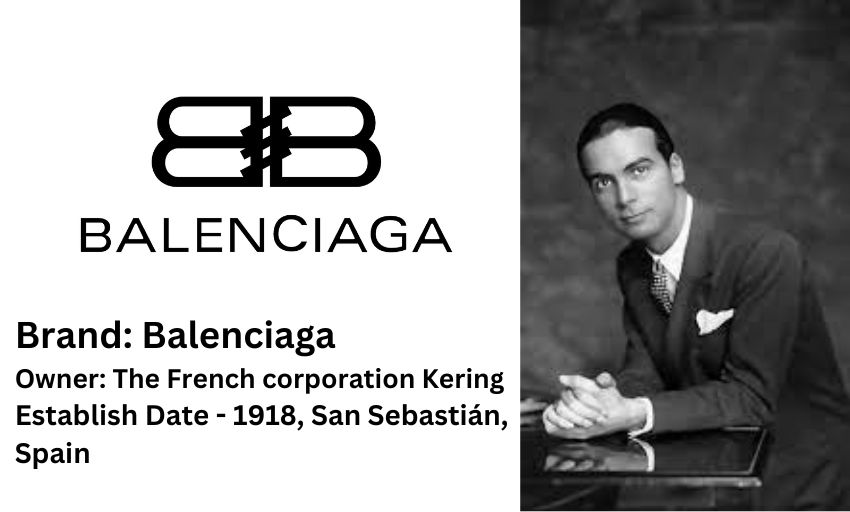
The Balenciaga fashion brand, known for its innovative designs, avant-garde silhouettes, and cutting-edge craftsmanship, has a rich history dating back to its founding by Spanish designer Cristóbal Balenciaga. Here is a brief history of the Balenciaga fashion brand:
Early Years and Spanish Heritage:
Cristóbal Balenciaga was born in 1895 in the Basque region of Spain. He displayed a passion for fashion from a young age and began his career as a tailor’s apprentice. Balenciaga’s exceptional talent and creativity soon gained recognition, leading him to open his first fashion house in San Sebastian, Spain, in 1918.
Paris Expansion and Global Influence:
In 1937, Balenciaga relocated his fashion house to Paris, the fashion capital of the world, where he gained prominence and influence. He quickly became renowned for his innovative designs, architectural silhouettes, and meticulous attention to detail. Balenciaga’s creations were characterized by their sculptural shapes, minimalism, and use of luxurious fabrics.
Shaping Fashion in the Post-War Era:
After World War II, Balenciaga played a significant role in redefining women’s fashion. His designs broke away from the restrictive and exaggerated styles of the previous era, offering women a more comfortable yet sophisticated alternative. Balenciaga’s “New Look” emphasized fluid lines, dropped waists, and voluminous skirts, marking a departure from the structured silhouettes of the past.
Iconic Designs and Innovations:
Balenciaga introduced several iconic designs and innovations throughout his career. The brand’s most famous creations include the “Baby Doll” dress, the “Sack” dress, and the “Balenciaga suit.” He was also known for his mastery of fabrics, employing techniques such as fabric manipulation, pleating, and draping to achieve dramatic and unique effects.
Legacy and Successors:
Cristóbal Balenciaga retired from the fashion industry in 1968 and passed away in 1972, leaving behind a legacy of innovation and craftsmanship. Following his departure, the fashion house experienced several changes in ownership and creative direction. Notable designers who have helmed the brand include Nicolas Ghesquière, who served as creative director from 1997 to 2012, and Alexander Wang, who held the position from 2012 to 2015.
Creative Renaissance under Demna Gvasalia:
Since 2015, Georgian fashion designer Demna Gvasalia has been at the helm of Balenciaga as creative director. Gvasalia brought a fresh and daring perspective to the brand, blending elements of streetwear with Balenciaga’s heritage of couture craftsmanship. His designs have challenged conventional fashion norms, featuring oversized proportions, deconstructed silhouettes, and unexpected juxtapositions.
Cultural Impact and Popularity:
Balenciaga’s designs have left an indelible mark on the fashion industry, influencing generations of designers and establishing the brand as an emblem of avant-garde luxury. Balenciaga’s creations continue to be celebrated for their architectural precision, artistic vision, and progressive approach to fashion.
Product Range and Global Presence:
The Balenciaga brand has expanded its offerings to include ready-to-wear collections for men and women, footwear, handbags, accessories, and fragrances. Balenciaga boutiques can be found in major fashion capitals worldwide, including Paris, New York, London, Tokyo, and Shanghai.
Today, the Balenciaga fashion brand remains at the forefront of the fashion industry, known for its boundary-pushing designs, impeccable craftsmanship, and the ability to challenge conventions. Balenciaga’s legacy lives on through its innovative and daring creations, continuing to shape the future of fashion.
15. Salvatore Ferragamo (Salvatore Ferragamo S.p.A.) –

The Salvatore Ferragamo fashion brand, named after its founder, is an iconic Italian luxury brand known for its exquisite craftsmanship, innovative designs, and timeless elegance. Here is a brief history of the Salvatore Ferragamo fashion brand:
Early Life and Career Beginnings:
Salvatore Ferragamo was born in 1898 in Bonito, Italy. He showed a passion for shoemaking from a young age and, at the age of nine, began apprenticing with a local shoemaker. Ferragamo later moved to the United States and settled in California, where he gained a reputation as a skilled and creative shoemaker.
Rise to Prominence in Hollywood:
In the 1920s, Salvatore Ferragamo relocated to Hollywood, where he opened a shop and quickly gained a following among celebrities and film stars. Ferragamo’s innovative designs, exceptional craftsmanship, and attention to comfort made him a favorite among the Hollywood elite. He became known as the “Shoemaker to the Stars.”
Return to Italy and the Creation of the Brand:
In 1927, Salvatore Ferragamo returned to Italy and settled in Florence. Inspired by the artistic and cultural heritage of the city, he established his eponymous fashion brand in 1927. The Salvatore Ferragamo brand initially focused on footwear but expanded its offerings to include handbags, accessories, and ready-to-wear collections.
Innovations and Technological Advancements:
Salvatore Ferragamo was known for his innovative approach to shoemaking. He constantly sought to improve comfort and functionality by experimenting with new materials and techniques. Ferragamo introduced groundbreaking designs, such as the cork wedge heel and the invisible sandal, which became iconic symbols of his brand.
Clientele and Recognition:
Salvatore Ferragamo’s craftsmanship and attention to detail garnered him a loyal clientele of international dignitaries, celebrities, and royalty. He became renowned for his ability to create custom-made shoes that perfectly fit the individual needs and preferences of his clients. His creations became synonymous with luxury, quality, and style.
Family Business and Expansion:
After Salvatore Ferragamo’s passing in 1960, his wife Wanda took over the company, managing it with great success. The Ferragamo family expanded the brand’s offerings to include men’s and women’s ready-to-wear collections, accessories, and fragrances. They also established a global retail presence, opening boutiques in major cities around the world.
Artistic Collaborations and Inspirations:
The Salvatore Ferragamo brand has collaborated with renowned artists and designers, further cementing its status as a creative and innovative force in the fashion industry. Collaborations have included partnerships with artists like Edgardo Osorio and fashion designers such as Karl Lagerfeld and Massimiliano Giornetti.
Legacy and Continued Success:
The Salvatore Ferragamo brand remains one of the most revered luxury fashion houses in the world. It is known for its timeless designs, impeccable craftsmanship, and commitment to quality. The brand’s dedication to combining innovation with tradition has allowed it to evolve and remain relevant in an ever-changing fashion landscape.
Today, the Salvatore Ferragamo fashion brand continues to be celebrated for its elegant and sophisticated designs. It encompasses a wide range of products, including shoes, handbags, accessories, and ready-to-wear collections, all reflecting the brand’s enduring legacy of Italian craftsmanship and timeless style.
16. Yves Saint Laurent (Saint Laurent) –
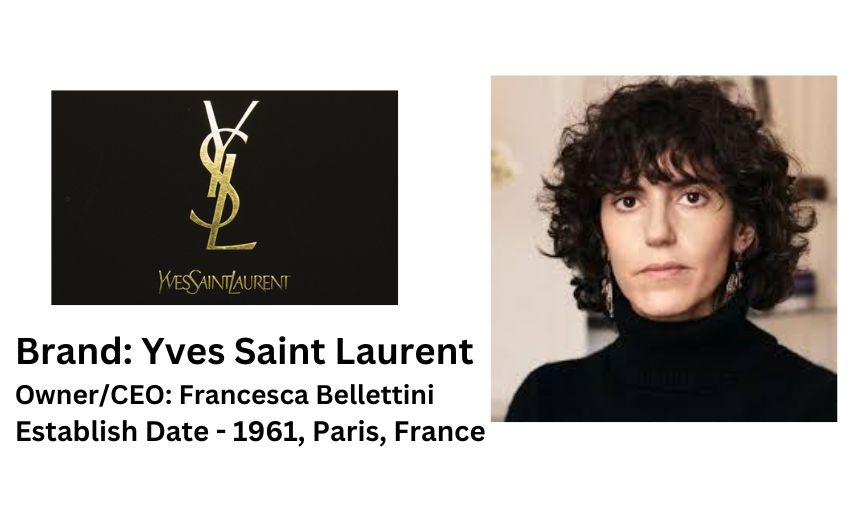
The Yves Saint Laurent fashion brand, often referred to as YSL, is an iconic French luxury fashion house known for its revolutionary designs and avant-garde approach to fashion. Here is a brief history of the Yves Saint Laurent fashion brand:
Early Life and Career Beginnings:
Yves Saint Laurent was born on August 1, 1936, in Oran, Algeria. He showed an early interest in fashion and began his career in the industry at a young age. Saint Laurent moved to Paris in the 1950s and studied fashion at the Chambre Syndicale de la Haute Couture.
Apprenticeship with Christian Dior:
In 1955, at the age of 19, Yves Saint Laurent caught the attention of renowned designer Christian Dior, who hired him as his assistant. Saint Laurent worked closely with Dior and, after Dior’s sudden death in 1957, became the head designer of the House of Dior at just 21 years old.
Launch of the Yves Saint Laurent Brand:
In 1961, Yves Saint Laurent established his eponymous fashion brand with his partner Pierre Bergé. The first Yves Saint Laurent collection, presented in 1962, received critical acclaim and marked the beginning of Saint Laurent’s journey as a groundbreaking designer. His designs challenged traditional norms and introduced new concepts, such as the “beatnik look” and “le smoking” tuxedo suit for women.
Revolutionizing Women’s Fashion:
Yves Saint Laurent played a pivotal role in revolutionizing women’s fashion. He introduced the concept of ready-to-wear clothing, making high fashion accessible to a wider audience. His designs combined masculine and feminine elements, pushing boundaries and redefining the notion of femininity. Saint Laurent’s creations were known for their bold colors, sharp tailoring, and innovative silhouettes.
Mondrian Collection and Pop Culture Influence:
Yves Saint Laurent’s iconic Mondrian Collection, presented in 1965, was inspired by the works of Dutch artist Piet Mondrian. The collection featured dresses and separates adorned with bold geometric color blocks, becoming an instant sensation. Saint Laurent’s designs became closely associated with the cultural and fashion movements of the 1960s and 1970s.
Fragrances and Accessories:
The Yves Saint Laurent brand expanded its offerings beyond clothing, introducing successful fragrances and accessories. The launch of the fragrance “Y” in 1964 marked the beginning of a fragrance line that would become synonymous with luxury and elegance. The brand also introduced iconic accessories, such as the “Muse” and “Sac de Jour” handbags, which have become coveted fashion staples.
Retirement and Brand Evolution:
Yves Saint Laurent announced his retirement from the fashion industry in 2002, following his final couture show. He was succeeded by a series of creative directors, including Tom Ford and Stefano Pilati, who brought their own unique visions to the brand. In 2012, Hedi Slimane took over as creative director and initiated a rebranding, changing the name to Saint Laurent Paris and adopting a more youthful and rock ‘n’ roll aesthetic.
Legacy and Continued Influence:
Yves Saint Laurent’s impact on the fashion industry cannot be overstated. His visionary designs, groundbreaking concepts, and artistic approach to fashion continue to inspire designers today. The Yves Saint Laurent brand remains a symbol of sophistication, elegance, and timeless style, with boutiques worldwide and a legacy that transcends decades.
Today, the Yves Saint Laurent brand, now under the creative direction of Anthony Vaccarello, continues to create innovative and luxurious collections that honor the brand’s heritage while embracing contemporary trends. The YSL name remains synonymous with high fashion and remains a leading force in the global fashion industry.
17. Versace (Gianni Versace S.r.l.) –
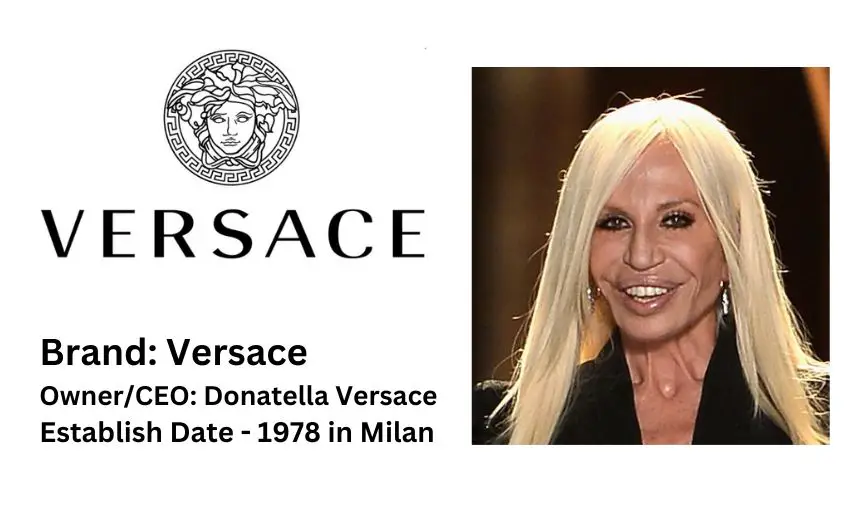
The Versace fashion brand, known for its bold designs, vibrant prints, and luxurious aesthetic, has a captivating history that spans several decades. Here is a brief overview of the history of the Versace fashion brand:
Founding of the Brand:
The Versace fashion brand was founded by Italian designer Gianni Versace in 1978. Born in Reggio Calabria, Italy, in 1946, Versace developed a passion for fashion at an early age. He learned the art of dressmaking from his mother, who ran a sewing business. Gianni Versace initially worked in various roles within the fashion industry, including designing for other labels and contributing to fashion publications.
Iconic Medusa Logo and Innovative Designs:
One of the hallmarks of the Versace brand is its iconic Medusa logo. The Medusa head, symbolizing power, allure, and mystique, has become synonymous with the Versace name. Versace’s designs were known for their boldness, sensuality, and flamboyance. He drew inspiration from diverse sources such as art, history, and pop culture, incorporating vibrant colors, intricate patterns, and luxurious materials into his creations.
Rise to Fame and Celebrity Following:
Versace quickly gained recognition and success, particularly in the 1980s and 1990s. His glamorous and provocative designs resonated with celebrities, musicians, and influential figures. Supermodels like Naomi Campbell, Claudia Schiffer, and Cindy Crawford became muses for the brand, and Versace’s fashion shows became renowned for their star-studded guest lists and extravagant presentations.
Expansion of Product Lines and Global Reach:
In addition to its ready-to-wear collections, the Versace brand expanded its offerings to include accessories, fragrances, home furnishings, and even a luxury resort chain. Versace also collaborated with other companies and designers, creating capsule collections and special projects. The brand expanded globally, opening boutiques in major cities worldwide, solidifying its position as a prominent luxury fashion house.
Tragic Loss of Gianni Versace:
In 1997, the fashion world was shocked by the untimely death of Gianni Versace. He was tragically murdered outside his Miami Beach home at the age of 50. His passing left a void in the fashion industry and in the Versace brand. Gianni’s sister, Donatella Versace, who had been involved in the company since its early days, assumed the role of creative director and took charge of continuing her brother’s legacy.
Donatella Versace’s Creative Direction:
Under Donatella’s leadership, the Versace brand continued to evolve while staying true to its distinctive style. She brought her own vision and design sensibilities to the brand, infusing it with a more modern and glamorous aesthetic. Donatella expanded collaborations with celebrities and artists, enhancing the brand’s cultural impact and maintaining its relevance in contemporary fashion.
Acquisitions and Partnerships:
In 2018, the Versace brand was acquired by the luxury fashion conglomerate Capri Holdings Limited, formerly known as Michael Kors Holdings Limited. This partnership provided resources and opportunities for further growth and global expansion while preserving the essence of the Versace brand.
Legacy and Influence:
The Versace brand has left an indelible mark on the fashion industry. Known for its boldness, opulence, and boundary-pushing designs, Versace has influenced generations of designers and has become an emblem of Italian luxury and glamour. The brand’s signature aesthetic, characterized by Medusa motifs, gold accents, and daring prints, continues to captivate fashion enthusiasts around the world.
Today, the Versace fashion brand remains an iconic symbol of luxury and style. With Donatella Versace at the creative helm, the brand continues to push creative boundaries, celebrate individuality, and create garments and accessories that exude confidence and allure.
18. Prada (Prada S.p.A.) –
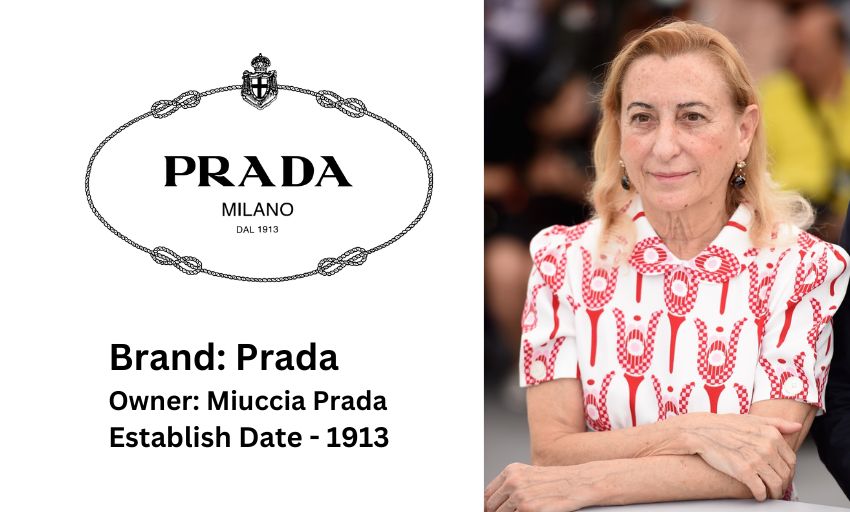
The Prada fashion brand, recognized for its minimalist designs, innovative materials, and sophisticated aesthetic, has a rich history spanning over a century. Here is a brief overview of the history of the Prada fashion brand:
Founding of the Brand:
Prada was founded by Mario Prada in 1913 in Milan, Italy. Originally known as Fratelli Prada (Prada Brothers), the company started as a small leather goods shop specializing in luxury accessories such as bags, trunks, and travel goods. The brand quickly gained a reputation for its exquisite craftsmanship and attention to detail.
Expansion and Success:
Mario Prada’s daughter, Luisa Prada, joined the family business in the 1950s and played a crucial role in expanding the brand’s offerings. Under her guidance, Prada began incorporating innovative materials like nylon into its designs, which became one of the brand’s defining characteristics. Prada’s designs were known for their clean lines, understated elegance, and focus on functionality.
Miuccia Prada’s Influence:
In the late 1970s, Miuccia Prada, Mario Prada’s granddaughter, took over the reins of the company. With her visionary approach, Miuccia Prada transformed the brand into a global fashion powerhouse. She introduced ready-to-wear collections for women in the late 1980s, challenging traditional notions of femininity and creating a new paradigm of modern luxury.
The Prada Aesthetic:
Prada’s aesthetic is often characterized by its minimalistic and refined designs. Miuccia Prada’s creations blended clean silhouettes, luxurious fabrics, and unexpected details to create a distinctive and intellectual style. Prada’s designs embraced simplicity while maintaining a sense of elegance and sophistication.
Collaborations and Artistic Inspirations:
Prada has collaborated with renowned artists, architects, and designers to infuse its collections with fresh perspectives and creativity. Collaborations with artists such as Damien Hirst and architects like Rem Koolhaas have helped Prada maintain its reputation as an innovative and forward-thinking brand. The brand has also drawn inspiration from various art movements and cultural references, incorporating them into its designs.
Miu Miu and Other Lines:
In addition to the main Prada brand, the company introduced Miu Miu in 1993, a secondary line designed by Miuccia Prada. Miu Miu offers a youthful and playful take on fashion, targeting a younger demographic. Prada has also expanded its product lines to include accessories, footwear, fragrances, and eyewear, further solidifying its presence in the luxury market.
Sustainability and Social Responsibility:
Prada has made efforts to prioritize sustainability and social responsibility in its practices. The company has implemented initiatives to reduce its environmental impact, promote ethical sourcing, and support social causes. Prada’s commitment to sustainability reflects its dedication to responsible and conscientious fashion.
Global Presence and Influence:
Prada has established a global presence with boutiques in major cities worldwide. Its designs have attracted a diverse clientele, including celebrities, fashion enthusiasts, and influential figures. The brand’s influence extends beyond fashion, permeating popular culture and shaping contemporary style trends.
Today, the Prada fashion brand remains an influential force in the fashion industry, synonymous with timeless elegance, refined craftsmanship, and innovative design. With Miuccia Prada and Patrizio Bertelli (Miuccia’s husband) at the helm, the brand continues to evolve, redefine luxury, and inspire fashion enthusiasts around the world.
19. Hermès (Hermès International S.A.) –

The Hermès fashion brand, renowned for its exquisite craftsmanship, timeless elegance, and iconic luxury goods, has a rich history that dates back over 180 years. Here is a brief overview of the history of the Hermès fashion brand:
Founding of the Brand:
Hermès was founded in 1837 by Thierry Hermès in Paris, France. Initially, the company focused on crafting and selling high-quality harnesses and saddlery for the carriage trade. The brand quickly gained a reputation for its exceptional craftsmanship, attention to detail, and dedication to using the finest materials.
Expansion into Leather Goods:
As transportation methods shifted from carriages to automobiles, Hermès adapted and expanded its product offerings. In the late 19th century, the brand began producing leather bags, luggage, and accessories, maintaining its commitment to meticulous craftsmanship and superior quality.
Introduction of the Hermès Scarf:
In 1937, Hermès introduced its iconic silk scarf, known as the “Carré Hermès.” Designed by Robert Dumas, the scarf featured intricate patterns, vibrant colors, and exquisite detailing. The Carré Hermès became a symbol of luxury and elegance, beloved by fashion enthusiasts around the world.
Hermès Birkin and Kelly Bags:
Hermès gained international acclaim for its exceptional handcrafted bags, particularly the Birkin and Kelly bags. The Birkin bag, named after British actress and singer Jane Birkin, was created in 1984 in response to Birkin’s desire for a spacious yet stylish handbag. The Kelly bag, originally known as the Sac à Dépêches, gained popularity after actress Grace Kelly became a fan. Both bags have become highly coveted and are considered symbols of status and sophistication.
Expansion into Ready-to-Wear and Accessories:
In addition to its leather goods, Hermès expanded into ready-to-wear clothing, accessories, and perfumes. The brand’s clothing collections are known for their timeless silhouettes, exquisite fabrics, and impeccable tailoring. Hermès also offers a range of accessories, including belts, scarves, ties, and jewelry, all crafted with the same dedication to craftsmanship and quality.
Emphasis on Craftsmanship and Artistry:
One of the defining characteristics of Hermès is its unwavering commitment to craftsmanship. The brand employs skilled artisans who specialize in various traditional techniques, such as leatherworking, silk printing, and watchmaking. Each Hermès product is meticulously crafted by these artisans, ensuring the highest level of quality and attention to detail.
Family Ownership and Values:
Hermès has remained a family-owned company throughout its history. The Hermès family has consistently upheld the brand’s values of heritage, authenticity, and excellence. The company places great emphasis on maintaining its traditions, while also embracing innovation and evolving with the times.
Global Presence and Legacy:
Hermès has established a global presence with boutiques in major cities worldwide, attracting a discerning clientele seeking luxury and refinement. The brand’s legacy is characterized by its timeless designs, enduring quality, and dedication to craftsmanship, making it a symbol of prestige and sophistication.
Today, the Hermès fashion brand continues to thrive under the leadership of the Hermès family. With a diverse range of products that embody elegance and luxury, Hermès remains an influential force in the fashion industry, epitomizing timeless style and exceptional craftsmanship.
20. Louis Vuitton (Louis Vuitton Malletier) –
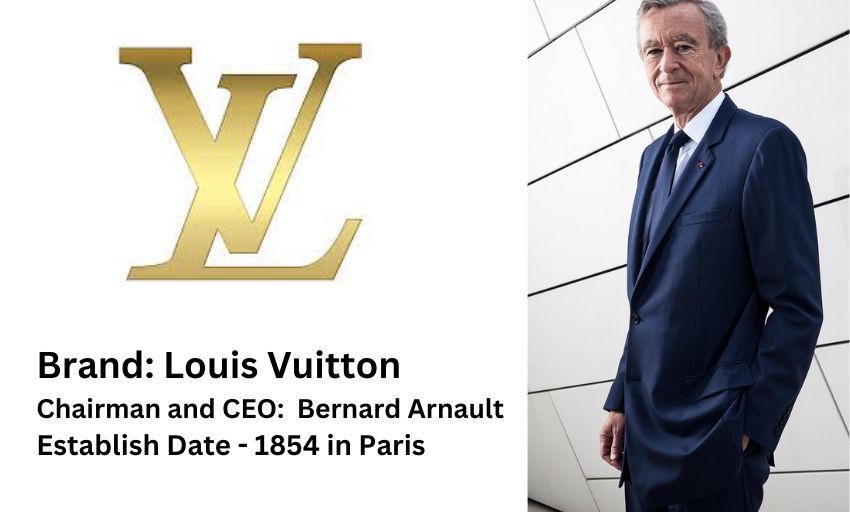
The Louis Vuitton fashion brand, renowned for its iconic monogrammed luggage, luxurious leather goods, and elegant fashion designs, has a rich history spanning over 160 years. Here is a brief overview of the history of the Louis Vuitton fashion brand:
Founding of the Brand:
Louis Vuitton Malletier, commonly referred to as Louis Vuitton or LV, was founded in 1854 by Louis Vuitton in Paris, France. Vuitton, who initially worked as a trunk maker and packer for high-profile clients, established his own company with the goal of revolutionizing luggage design and craftsmanship.
Innovation in Luggage Design:
At a time when travel involved bulky and cumbersome luggage, Louis Vuitton introduced innovative design features to make travel more convenient. Vuitton created flat-topped trunks, lightweight yet durable materials, and airtight and stackable designs, revolutionizing the world of luggage. His designs set new standards for functionality and luxury.
Signature Monogram and Iconic Patterns:
In 1896, Louis Vuitton’s son, Georges Vuitton, introduced the brand’s signature monogram canvas, which featured the intertwined LV initials and floral motifs. This monogram became the iconic symbol of Louis Vuitton and remains an integral part of the brand’s identity. Over the years, the brand expanded its patterns to include checkerboard prints, Damier canvas, and various collaborations with artists and designers.
Expansion into Leather Goods:
In addition to luggage, Louis Vuitton began producing leather goods, such as handbags, wallets, and accessories. The brand’s commitment to quality craftsmanship and attention to detail extended to its leather products, which became highly sought-after for their elegance and durability.
Growth and International Expansion:
Louis Vuitton experienced significant growth under the leadership of subsequent generations of the Vuitton family. The brand expanded its reach beyond France, opening stores in other European cities and eventually establishing a global presence. Louis Vuitton boutiques now span major cities around the world, catering to a discerning clientele seeking luxury and sophistication.
Collaboration with Designers and Artists:
Louis Vuitton has collaborated with renowned designers and artists to infuse its collections with innovation and artistic flair. Collaborations with artists such as Stephen Sprouse, Takashi Murakami, and Jeff Koons have resulted in limited-edition collections that blend fashion and art, creating a unique fusion of creativity and luxury.
Diversification into Ready-to-Wear and Accessories:
While Louis Vuitton initially focused on luggage and leather goods, the brand expanded into ready-to-wear fashion, footwear, accessories, and jewelry. Its clothing collections showcase a combination of timeless elegance and contemporary design, offering a complete lifestyle experience to its clientele.
Commitment to Sustainability and Corporate Social Responsibility:
In recent years, Louis Vuitton has prioritized sustainability and corporate social responsibility initiatives. The brand is dedicated to reducing its environmental impact, promoting ethical sourcing, and supporting various social and philanthropic causes.
Today, Louis Vuitton is recognized as one of the world’s leading luxury fashion brands. With a rich heritage, a commitment to craftsmanship, and a portfolio that encompasses a wide range of products, Louis Vuitton continues to shape the fashion industry and inspire global trends, while remaining true to its tradition of excellence and luxury.
Most People Also Love To Read These Useful Topics –
- 17 Clever Ways Of How to Wear a Backless Dress With Big Bust
- How to Go Braless at Work With Formal Outfits In Summer & Winter – 13 Best Options
- What to Wear Over Formal Dress When Cold – 15 Great Options
- 25 Ways Of How to Make a Backless Dress Modest in 5 Methods
- How to Cover Spaghetti Strap Dress in 13 Ways – Advice From Tory Burch
- How to Hide Bra Straps With Spaghetti Straps – Easy And Simple Tricks
- How to Wear Spaghetti Straps Modestly – 4 Steps
- 7 Effective Tips For What to Wear Under Spaghetti Strap Dress – What Vera Wang’s Thoughts
Frequently Asked Questions For The Top Fashion Brands Longest Name
Q: What is the significance of Balenciaga’s long name?
A: Balenciaga’s lengthy name reflects the brand’s rich heritage and Spanish roots. It pays homage to its founder, Cristóbal Balenciaga, who believed in creating timeless and extraordinary fashion.
Q: How did Alexander McQueen’s fashion house acquire its tongue-twisting name?
A: The fashion house was named after its founder, Lee Alexander McQueen. The inclusion of his full name in the brand highlights his immense talent and artistic vision, making it unforgettable.
Q: Why does Christian Dior have such a long brand name?
A: Christian Dior’s lengthy brand name encompasses the full name of its founder, Christian Dior, showcasing his influence and marking the brand’s commitment to elegance, luxury, and impeccable style.
Q: What inspired Gucci to choose a long and lavish brand name?
A: Gucci’s long and opulent brand name represents the brand’s commitment to high-end fashion, Italian craftsmanship, and its founder, Guccio Gucci. The name echoes the grandeur associated with the brand.
Q: How did Louis Vuitton’s name become synonymous with luxury, despite its length?
A: The lengthy name of Louis Vuitton originated from its founder, Louis Vuitton, who revolutionized luggage design. Over time, the brand’s commitment to exquisite craftsmanship and timeless luxury made its long name iconic.
Q: What is the story behind Dolce & Gabbana’s lengthy brand name?
A: The brand’s name comes from its founders, Domenico Dolce and Stefano Gabbana, who wanted their names to represent their creative partnership. The length of the brand name adds a touch of exclusivity and sophistication.
Q: How did Versace’s name evolve into its lengthy form?
A: The name “Versace” stems from its founder, Gianni Versace. The inclusion of his full name emphasizes the personal touch and artistic vision behind the brand, symbolizing the enduring legacy of its founder.
Q: Why does Maison Margiela have a mysterious and multifaceted lengthy name?
A: Maison Margiela’s lengthy name reflects the brand’s avant-garde and conceptual approach to fashion. The enigmatic nature of the name aligns with the brand’s innovative designs and unconventional artistic vision.
Q: What inspired the name “Hermès” and its association with luxury?
A: Hermès, named after its founder, Thierry Hermès, has become synonymous with luxury and refinement. The long name signifies the brand’s commitment to quality, craftsmanship, and the timeless elegance of French fashion.
Q: How does Saint Laurent’s lengthy brand name encapsulate its timeless sophistication?
A: The name “Saint Laurent” pays tribute to the brand’s iconic founder, Yves Saint Laurent. The inclusion of his full name in the brand showcases the enduring legacy of his designs, which embody timeless sophistication and elegance.
Final Opinion Of Top Fashion Brands Longest Name
As the fashion industry continues to evolve, these top fashion brands with the longest names will likely continue to shape and influence the future of fashion. Their dedication to craftsmanship, innovation, and individuality ensures that they will remain significant players in the fashion world for years to come.
